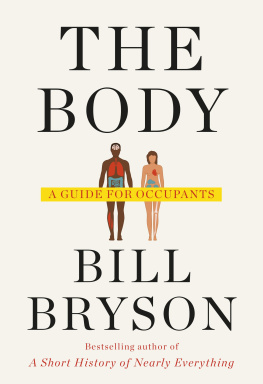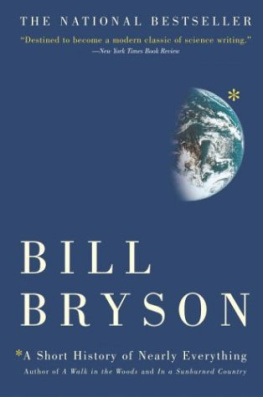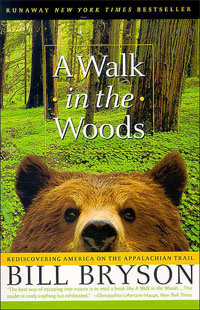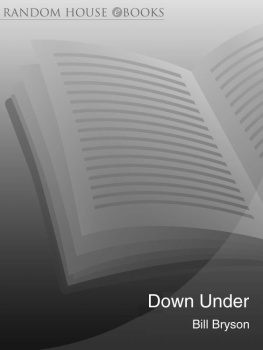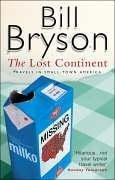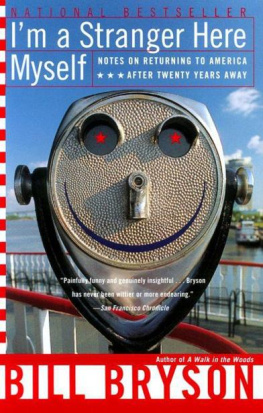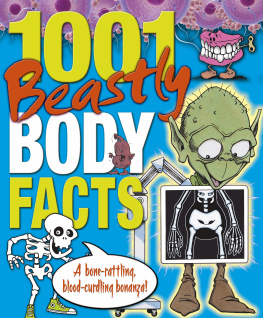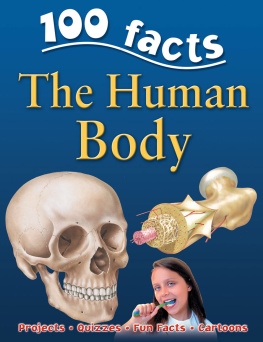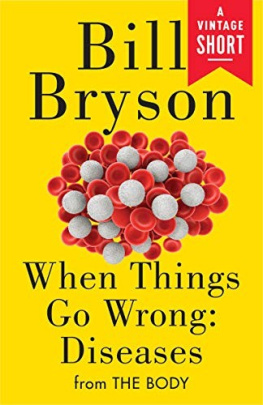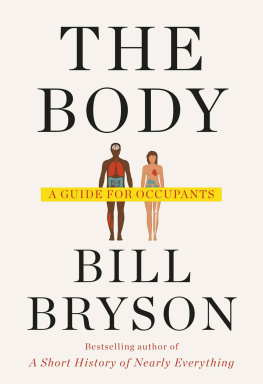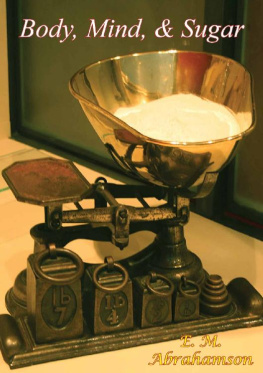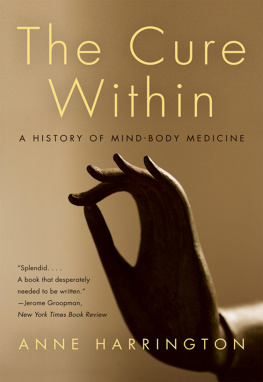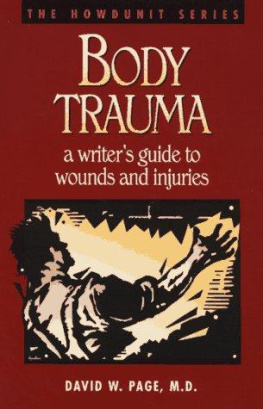Bryson - The Body A Guide for Occupants
Here you can read online Bryson - The Body A Guide for Occupants full text of the book (entire story) in english for free. Download pdf and epub, get meaning, cover and reviews about this ebook. year: 2019, publisher: Knopf Doubleday Publishing Group, genre: Romance novel. Description of the work, (preface) as well as reviews are available. Best literature library LitArk.com created for fans of good reading and offers a wide selection of genres:
Romance novel
Science fiction
Adventure
Detective
Science
History
Home and family
Prose
Art
Politics
Computer
Non-fiction
Religion
Business
Children
Humor
Choose a favorite category and find really read worthwhile books. Enjoy immersion in the world of imagination, feel the emotions of the characters or learn something new for yourself, make an fascinating discovery.
- Book:The Body A Guide for Occupants
- Author:
- Publisher:Knopf Doubleday Publishing Group
- Genre:
- Year:2019
- Rating:3 / 5
- Favourites:Add to favourites
- Your mark:
- 60
- 1
- 2
- 3
- 4
- 5
The Body A Guide for Occupants: summary, description and annotation
We offer to read an annotation, description, summary or preface (depends on what the author of the book "The Body A Guide for Occupants" wrote himself). If you haven't found the necessary information about the book — write in the comments, we will try to find it.
The Body A Guide for Occupants — read online for free the complete book (whole text) full work
Below is the text of the book, divided by pages. System saving the place of the last page read, allows you to conveniently read the book "The Body A Guide for Occupants" online for free, without having to search again every time where you left off. Put a bookmark, and you can go to the page where you finished reading at any time.
Font size:
Interval:
Bookmark:
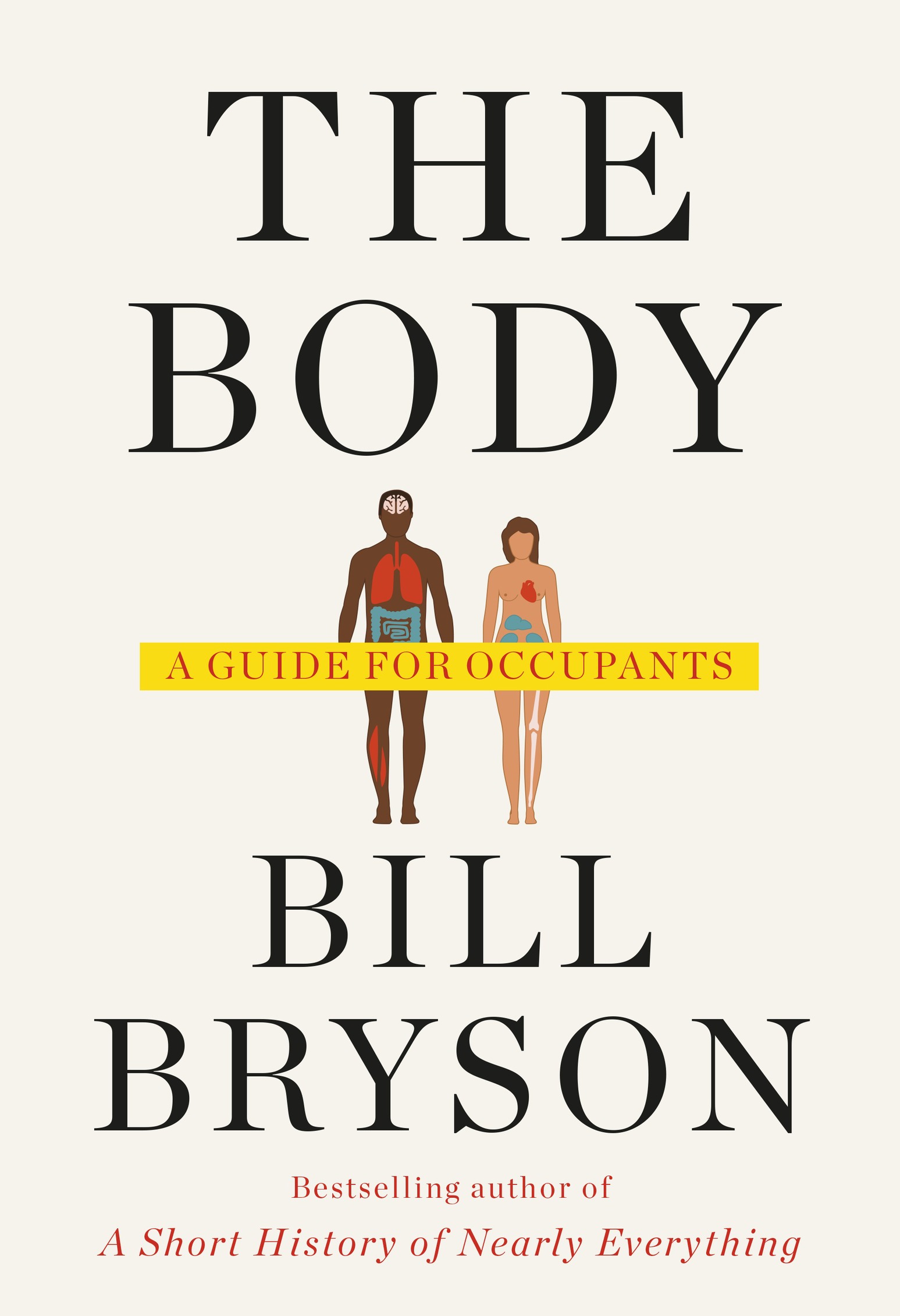
The Lost Continent
The Mother Tongue
Neither Here Nor There
Made in America
Notes from a Small Island
A Walk in the Woods
Im a Stranger Here Myself
In a Sunburned Country
Brysons Dictionary of Troublesome Words
Bill Brysons African Diary
A Short History of Nearly Everything
A Short History of Nearly Everything: Special Illustrated Edition
The Life and Times of the Thunderbolt Kid
Shakespeare: The World as Stage
Brysons Dictionary for Writers and Editors
At Home: A Short History of Private Life
At Home: A Short History of Private Life: Illustrated Edition
One Summer
The Road to Little Dribbling: Adventures of an American in Britain
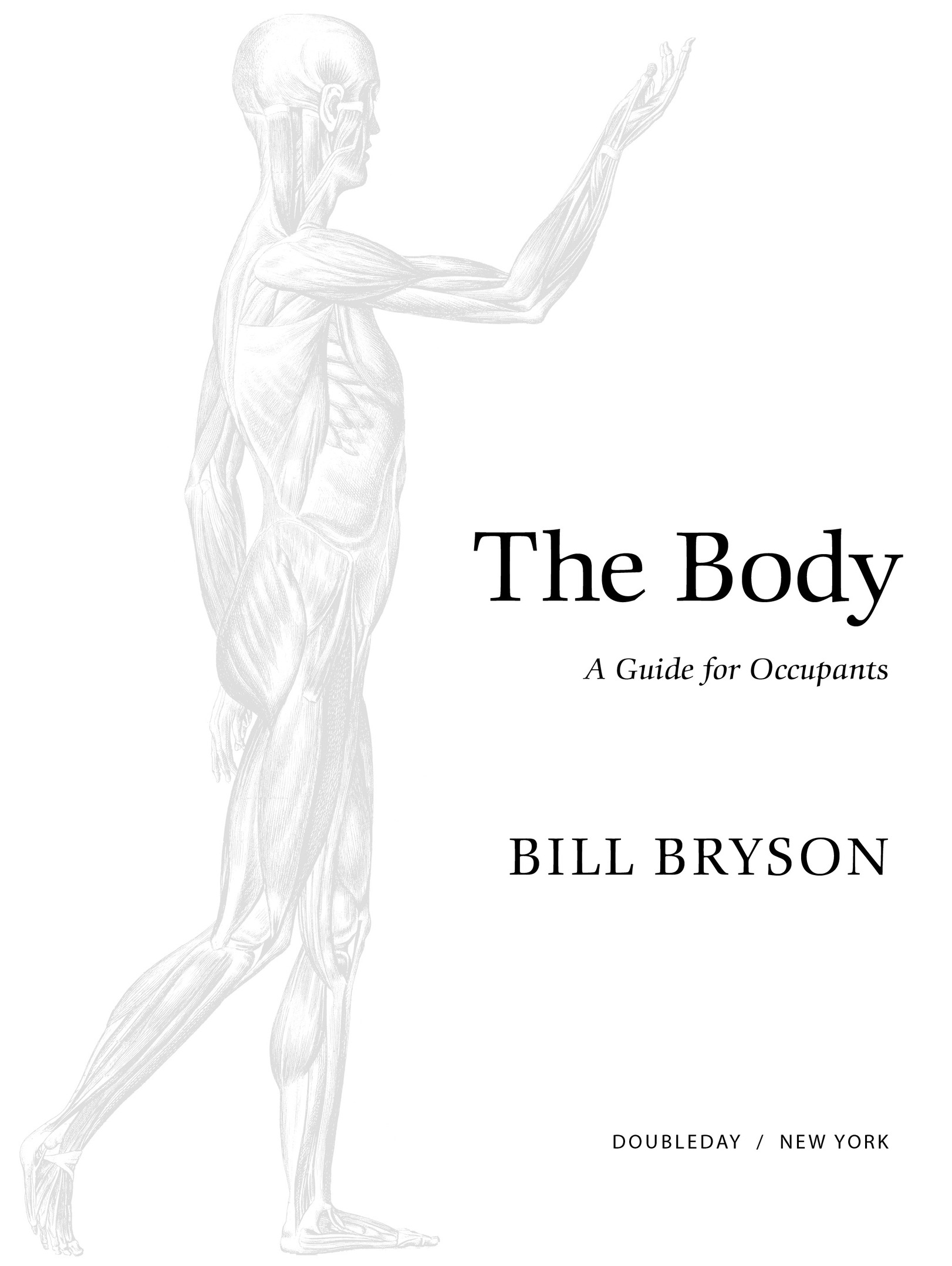
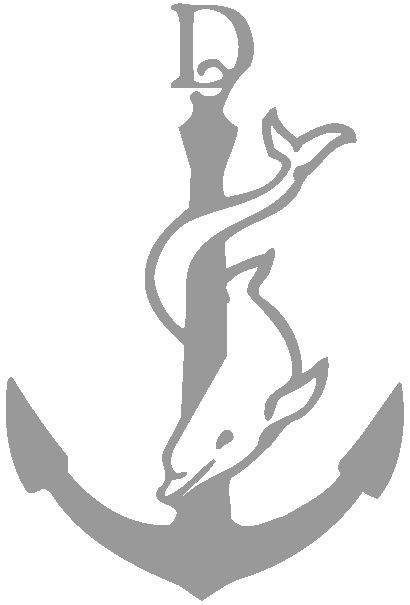
Copyright 2019 by Bill Bryson
All rights reserved. Published in the United States by Doubleday, a division of Penguin Random House LLC, New York. Simultaneously published in hardcover in Great Britain by Doubleday, an imprint of Transworld Publishers, a division of Penguin Random House Ltd., London, in 2019.
www.doubleday.com
DOUBLEDAY and the portrayal of an anchor with a dolphin are registered trademarks of Penguin Random House LLC.
Grateful acknowledgment is made to Harvard University Press for permission to reprint excerpts from The Poems of Emily Dickinson: Variorum Edition, edited by Ralph W. Franklin, Cambridge, Mass.: The Belknap Press of Harvard University Press. Copyright 1998 by the President and Fellows of Harvard College. Copyright 1951, 1955 by the President and Fellows of Harvard College, copyright renewed 1979, 1983 by the President and Fellows of Harvard College. Copyright 1914, 1918, 1919, 1924, 1929, 1930, 1932, 1935, 1937, 1942 by Martha Dickinson Bianchi. Copyright 1952, 1957, 1958, 1963, 1965 by Mary L. Hampson.
constitutes an extension of this copyright page.
Cover design by John Gall
Cover composite image by Aleksandr Andreev and robuart / Shutterstock
Library of Congress Cataloging-in-Publication Data
Names: Bryson, Bill, author.
Title: The body: a guide for occupants / Bill Bryson.
Description: First edition. | New York: Doubleday, 2019. | Includes
bibliographical references and index.
Identifiers: LCCN 2019012407 | ISBN 9780385539302 (hardcover) | ISBN 9780385539319 (ebook)
Subjects: LCSH: Human anatomy. | Human physiology. | BISAC: SCIENCE / Life Sciences / Human Anatomy & Physiology. | MEDICAL / Anatomy. | HUMOR / General.
Classification: LCC QM23.2 .B79 2019 | DDC 612dc23
LC record available at https://lccn.loc.gov/2019012407
Ebook ISBN9780385539319
v5.4
ep
To Lottie. Welcome to you, too.
How like a god!
WILLIAM SHAKESPEARE
LONG AGO, WHEN I was a junior high school student in Iowa, I remember being taught by a biology teacher that all the chemicals that make up a human body could be bought in a hardware store for $5.00 or something like that. I dont recall the actual sum. It might have been $2.97 or $13.50, but it was certainly very little even in 1960s money, and I remember being astounded at the thought that you could make a slouched and pimply thing such as me for practically nothing.
It was such a spectacularly humbling revelation that it has stayed with me all these years. The question is, was it true? Are we really worth so little?
Many authorities (for which possibly read science majors who dont have a date on a Friday) have tried at various times, mostly for purposes of amusement, to compute how much it would cost in materials to build a human. Perhaps the most respectable and comprehensive attempt of recent years was done by Britains Royal Society of Chemistry when, as part of the 2013 Cambridge Science Festival, it calculated how much it would cost to assemble all the elements necessary to build the actor Benedict Cumberbatch. (Cumberbatch was the guest director of the festival that year and was, conveniently, a typically sized human.)
Altogether, according to RSC calculations, fifty-nine elements are needed to construct a human being. Six of thesecarbon, oxygen, hydrogen, nitrogen, calcium, and phosphorusaccount for 99.1 percent of what makes us, but much of the rest is a bit unexpected. Who would have thought that we would be incomplete without some molybdenum inside us, or vanadium, manganese, tin, and copper? Our requirements for some of these, it must be said, are surpassingly modest and are measured in parts per million or even parts per billion. We need, for instance, just 20 atoms of cobalt and 30 of chromium for every 999,999,999 atoms of everything else.
The biggest component in any human, filling 61 percent of available space, is oxygen. It may seem a touch counterintuitive that we are almost two-thirds composed of an odorless gas. The reason we are not light and bouncy like a balloon is that the oxygen is mostly bound up with hydrogen (which accounts for another 10 percent of you) to make waterand water, as you will know if you have ever tried to move a wading pool or just walked around in really wet clothes, is surprisingly heavy. It is a little ironic that two of the lightest things in nature, oxygen and hydrogen, when combined form one of the heaviest, but thats nature for you. Oxygen and hydrogen are also two of the cheaper elements within you. All your oxygen will set you back just $14 and your hydrogen a little over $26 (assuming you are about the size of Benedict Cumberbatch). Your nitrogen (2.6 percent of you) is a better value still at just forty cents for a bodys worth. But after that it gets pretty expensive.
You need about thirty pounds of carbon, and that will cost you $69,550, according to the Royal Society of Chemistry. (They were using only the most purified forms of everything. The RSC would not make a human with cheap stuff.) Calcium, phosphorus, and potassium, though needed in much smaller amounts, would between them set you back a further $73,800. Most of the rest is even more expensive per unit of volume, but fortunately only needed in microscopic amounts. Thorium costs over $3,000 per gram but constitutes just 0.0000001 percent of you, so you can buy a bodys worth for thirty-three cents. All the tin you require can be yours for six cents, while zirconium and niobium will cost you just three cents apiece. The 0.000000007 percent of you that is samarium isnt apparently worth charging for at all. Its logged in the RSC accounts as costing $0.00.
Of the fifty-nine elements found within us, twenty-four are traditionally known as essential elements, because we really cannot do without them. The rest are something of a mixed bag. Some are clearly beneficial, some may be beneficial but we are not sure in what ways yet, others are neither harmful nor beneficial but are just along for the ride as it were, and a few are just bad news altogether. Cadmium, for instance, is the twenty-third most common element in the body, constituting 0.1 percent of your bulk, but it is seriously toxic. We have it in us not because our body craves it but because it gets into plants from the soil and then into us when we eat the plants. If you are from North America, you probably ingest about eighty micrograms of cadmium a day, and no part of it does you any good at all.
Font size:
Interval:
Bookmark:
Similar books «The Body A Guide for Occupants»
Look at similar books to The Body A Guide for Occupants. We have selected literature similar in name and meaning in the hope of providing readers with more options to find new, interesting, not yet read works.
Discussion, reviews of the book The Body A Guide for Occupants and just readers' own opinions. Leave your comments, write what you think about the work, its meaning or the main characters. Specify what exactly you liked and what you didn't like, and why you think so.

